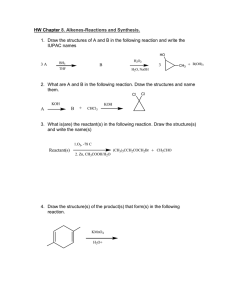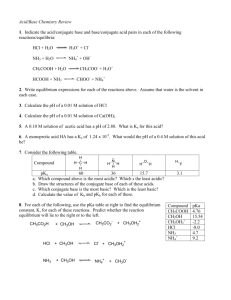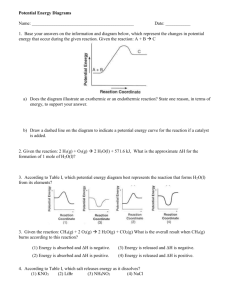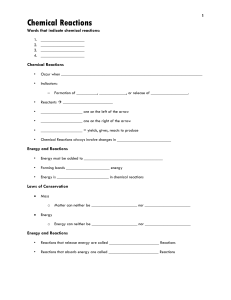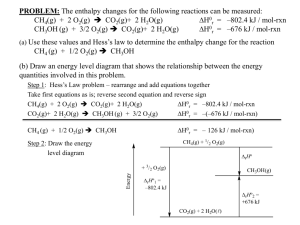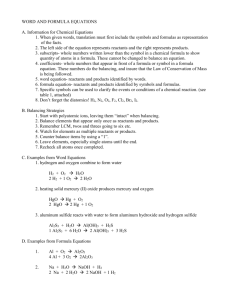Rate law determination
advertisement
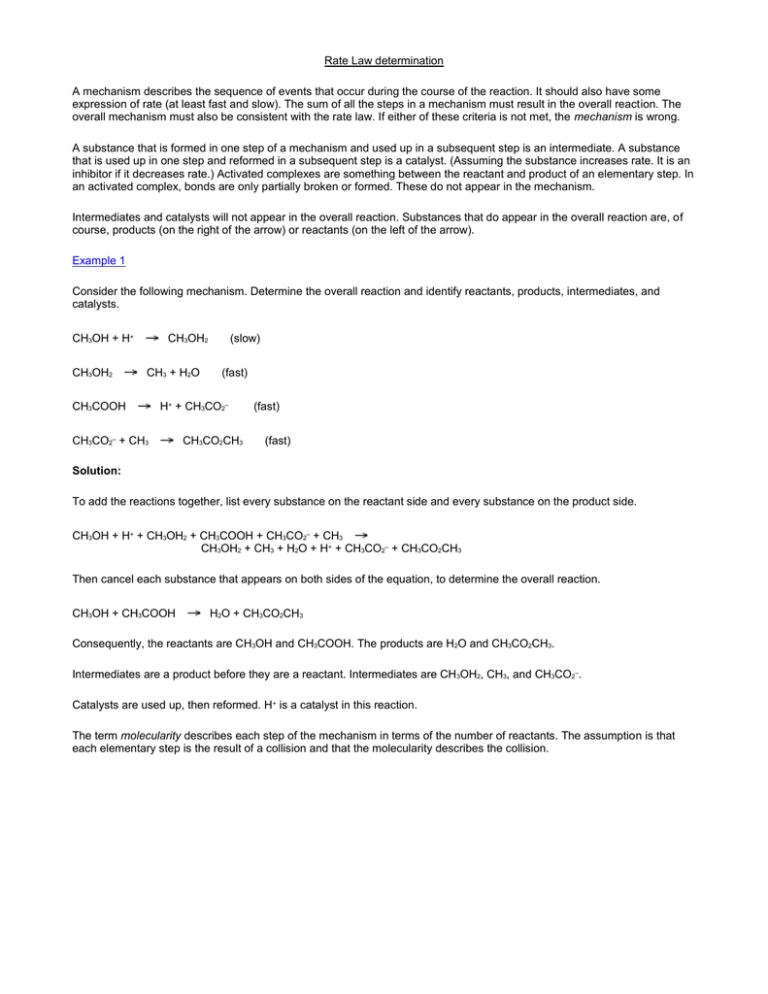
Rate Law determination A mechanism describes the sequence of events that occur during the course of the reaction. It should also have some expression of rate (at least fast and slow). The sum of all the steps in a mechanism must result in the overall reaction. The overall mechanism must also be consistent with the rate law. If either of these criteria is not met, the mechanism is wrong. A substance that is formed in one step of a mechanism and used up in a subsequent step is an intermediate. A substance that is used up in one step and reformed in a subsequent step is a catalyst. (Assuming the substance increases rate. It is an inhibitor if it decreases rate.) Activated complexes are something between the reactant and product of an elementary step. In an activated complex, bonds are only partially broken or formed. These do not appear in the mechanism. Intermediates and catalysts will not appear in the overall reaction. Substances that do appear in the overall reaction are, of course, products (on the right of the arrow) or reactants (on the left of the arrow). Example 1 Consider the following mechanism. Determine the overall reaction and identify reactants, products, intermediates, and catalysts. CH3OH + H+ CH3OH2 CH3OH2 CH3 + H2O CH3COOH (slow) (fast) H+ + CH3CO2– CH3CO2– + CH3 CH3CO2CH3 (fast) (fast) Solution: To add the reactions together, list every substance on the reactant side and every substance on the product side. CH3OH + H+ + CH3OH2 + CH3COOH + CH3CO2– + CH3 CH3OH2 + CH3 + H2O + H+ + CH3CO2– + CH3CO2CH3 Then cancel each substance that appears on both sides of the equation, to determine the overall reaction. CH3OH + CH3COOH H2O + CH3CO2CH3 Consequently, the reactants are CH3OH and CH3COOH. The products are H2O and CH3CO2CH3. Intermediates are a product before they are a reactant. Intermediates are CH3OH2, CH3, and CH3CO2–. Catalysts are used up, then reformed. H+ is a catalyst in this reaction. The term molecularity describes each step of the mechanism in terms of the number of reactants. The assumption is that each elementary step is the result of a collision and that the molecularity describes the collision. >> Example 2 Describe the molecularity of each step in the following mechanism. CH3OH + H+ CH3OH2 CH3OH2 CH3 + H2O (slow) (fast) H+ + CH3CO2– CH3COOH CH3CO2– + CH3 (fast) CH3CO2CH3 (fast) Solution: The first and last steps are bimolecular (two reactants). The two middle steps are unimolecular (one reactant). Rate Law Rate is determined from the slowest step in the mechanism. For this reason the rate-determining step is the slowest step. The rate law is based on the slow step. Rate is proportional to the product of the concentration of reactants in the slow step. >> Example 3 What rate law is predicted by the following mechanism? CH3OH + H+ CH3OH2 CH3OH2 CH3 + H2O CH3COOH (slow) (fast) H+ + CH3CO2– CH3CO2– + CH3 (fast) CH3CO2CH3 (fast) Solution: The reactants are CH3OH and H+ in the slow step. Since rate is proportional to the concentration of those substances, the rate law for this mechanism is rate = k[CH3OH][H+] Note that it conforms to the general form of the rate law. Example 5 Which mechanism corresponds to the reaction SO2 + H2O a. b. H2O H + OH (slow) SO2 + OH HSO2 (fast) HSO2 + H H2SO3 (fast) SO2 + H2O HSO2 + OH (slow) H2SO3 if the rate law for the reaction is rate = k[H2O]? OH + HSO2 c. H2O H + OH H + SO2 H2O (fast) (slow) HSO2 HSO2 + OH d. H2SO3 (fast) H2SO3 H + OH (fast) (slow) OH + SO2 HSO2 + O O + HSO2 HSO3 HSO3 + H H2 + SO3 (fast) (fast) (fast) Solution: The rate law is determined by the slow step, which is the first step for each of these proposed mechanisms. Therefore the rate law is easily written. a. b. c. d. The proposed rate law is rate = k[H2O]. This is consistent with the experimental rate law, so this mechanism may be correct. The proposed rate law is rate = k[H2O][SO2]. This does not match the experimental rate law, so this mechanism is incorrect. The proposed rate law is rate = k[H2O]. This is consistent with the experimental rate law, so this mechanism may be correct. The proposed rate law is rate = k[H2O], but the overall reaction does not correspond to the experimental reaction. Therefore this mechanism is incorrect. Either mechanism a or c is correct. There is insufficient evidence to determine which. It is also possible that the correct mechanism is something completely different. Determining the Rate Law Kinetics Experiments The goal of a kinetics experiment is to measure the concentration of a species at a particular time during a reaction so that a rate law can be determined. However, it is exceedingly difficult to get an accurate measurement of a concentration at a known time because the techniques used to measure concentrations don't work instantaneously, but rather take time to perform. One of the earliest methods used to measure concentrations at specified times is to quench the reaction either by flash freezing it or by adding a substance that severely inhibits the reaction. Both of these techniques are problematic because one can't be sure that the reaction has completely stopped. The reaction may still be going on during the analysis. Additionally, the reaction mixture is destroyed for the purposes of kinetic experiments, so the chemist must make multiple trial runs and waste a large amount of reagents to observe the concentrations at multiple points in time. A more modern technique to measure concentration is absorbance spectroscopy. This experiment may be used when a product or reactant has an absorbance frequency unique to those of other components of the reaction mixture. By measuring the absorbance of a particular product or reactant at a variety of known concentrations, you can construct a plot of absorbance versus concentration called a Beer's Law plot. This calibration chart allows you to calculate the unknown concentration given the reaction solution's absorbance. The advantage of this method is that a large number of data points with well known times can be quickly collected using only one reaction mixture. Method of Initial Rates When looking at the expression for the rate law below2.1, you should notice that the variables in the equation are the concentration terms and the powers p and q: Because we can measure the concentrations in the rate law using the techniques described above, the unknowns we wish to measure are k, p, and q. One method of directly measuring k, p, and q is called the method of initial rates. By measuring the initial rate (the rate near reaction time zero) for a series of reactions with varying concentrations, we can deduce to what power the rate depends on the concentration of each reagent. For example, let's use the method of initial rates to determine the rate law for the following reaction: whose rate law has the form: Using the following initial rates data, it is possible to calculate the order of the reaction for both bromine and acetone: Figure 2.4: Initial rates data for the bromination of acetone To calculate the order of the reaction for bromine, notice that experiments 1 and 2 hold the concentration of acetone constant while doubling the concentration of bromine. The initial rate of the reaction is unaffected by the increase in bromine concentration, so the reaction is zero order in bromine. We can prove this mathematically by taking the ratio of the rates from experiments 1 and two: As you can see in the above equations, by holding the concentrations of all but one species constant between two experiments, you can calculate the order of the reaction in a single reactant at a time. By similar reasoning, we can conclude that because the rate of reaction doubled when the concentration of acetone was doubled (cf. experiments 1 and 3) the reaction must be first order in acetone. However, had the rate quadrupled or octupled with a doubling of the acetone concentration, the reaction would have been second or third order in acetone, respectively. In practice, you will likely never see a reaction with an order higher than 3. If you calculate an order higher than 3 for a reaction, double check your math because that is highly unusual. If you compute a fractional power for a reactant's order, do not be discouraged; they are quite common (especially half-order reactions). To calculate the value of k, the rate constant, you simply plug into the rate law the values of the concentrations, the orders, and the rate of the reaction from any one of the three experiments. All three experiments should give a value of 1.64 x 10-4 s-1. You should prove this to yourself.
